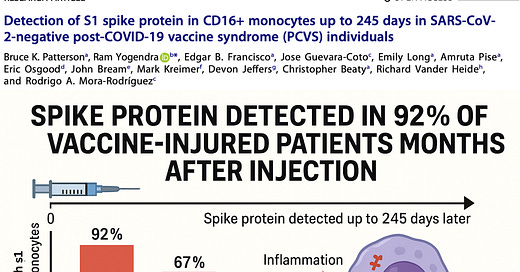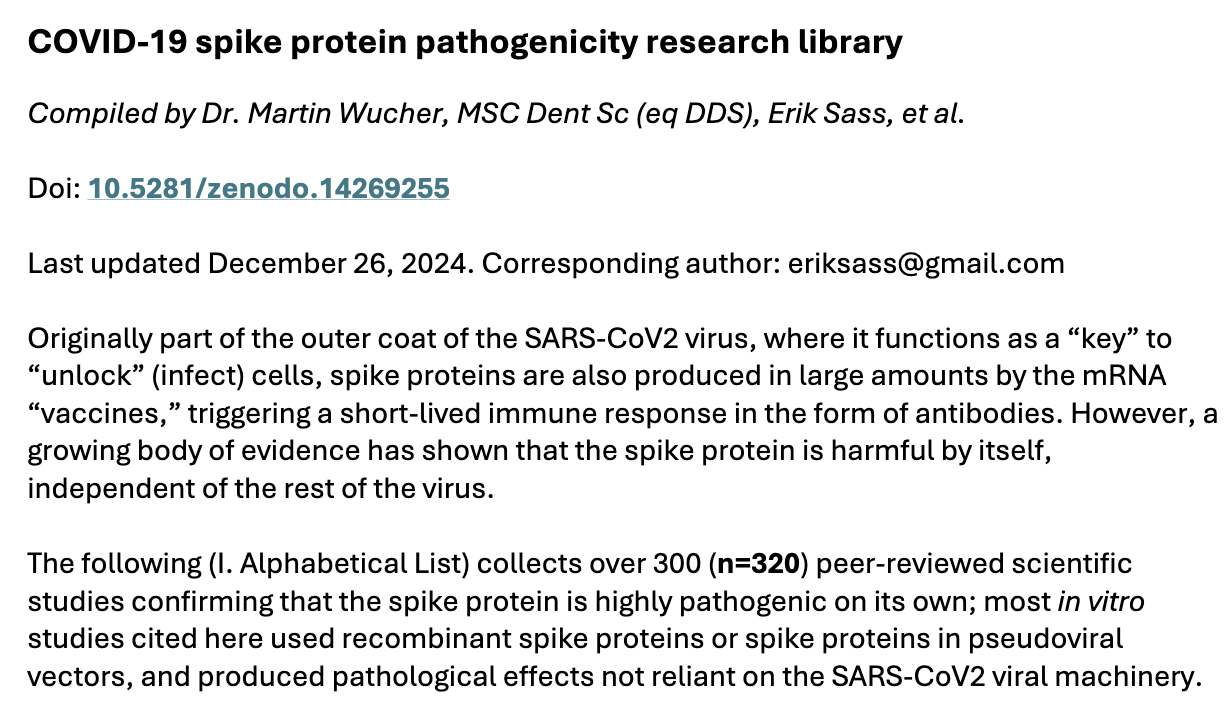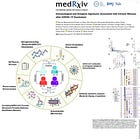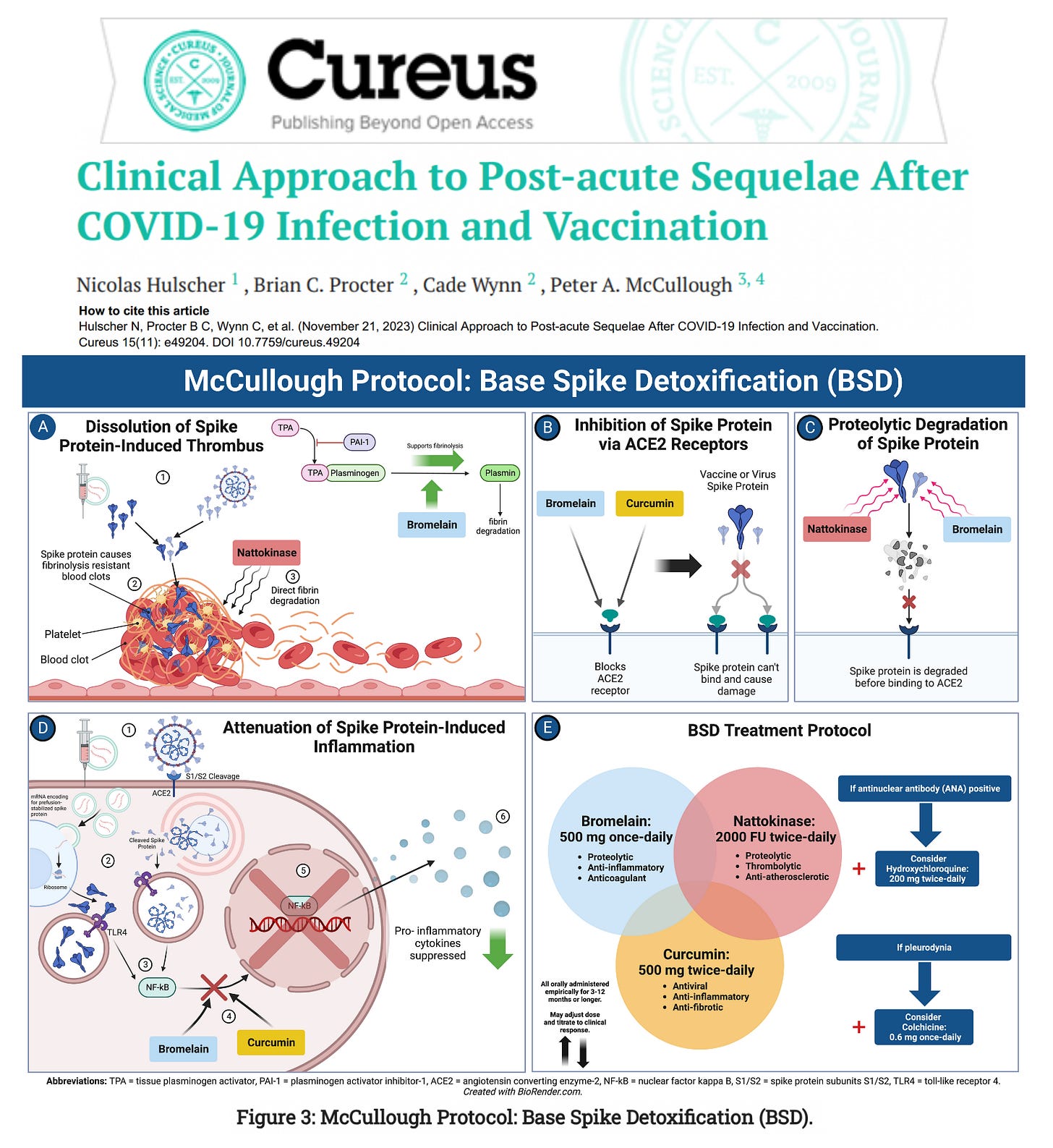NEW STUDY — Spike Protein Detected in 92% of Vaccine-Injured Patients Up to 245 Days After Injection
92% of symptomatic individuals with post-vaccine syndrome had spike protein in their immune cells up to 8 months after injection—raising serious concerns about post-vaccination chronic disease burden.
The study titled, Detection of S1 spike protein in CD16+ monocytes up to 245 days in SARS-CoV-2-negative post-COVID-19 vaccine syndrome (PCVS) individuals, was just published in the journal Human Vaccines & Immunotherapeutics:
ABSTRACT
Despite over 13 billion SARS-CoV-2 vaccine doses administered globally, persistent post-vaccination symptoms, termed post-COVID-19 vaccine syndrome (PCVS), resemble post-acute sequelae of COVID-19 (PASC). Symptoms like cardiac, vascular, and neurological issues often emerge shortly after vaccination and persist for months to years, mirroring PASC. We previously showed the S1 subunit of the SARS-CoV-2 spike protein persists in CD16+ monocytes after infection, potentially driving PASC. Approved vaccines (Pfizer, Moderna, Janssen, AstraZeneca) deliver synthetic S1 to elicit immunity, suggesting a shared mechanism. We hypothesized that vaccine-derived S1 persistence in CD16+ monocytes sustains inflammation akin to PASC, contributing to PCVS. We studied 50 individuals with PCVS symptoms lasting over 30 days post-vaccination and 26 asymptomatic controls, using (1) machine learning-based immune profiling to compare cytokine signatures with PASC, (2) flow cytometry to detect S1 in CD16+ monocytes, and (3) LC-MS to confirm S1 across vaccine types. We correlated S1 persistence with symptom duration and inflammation. Prior infection was excluded via clinical history, anti-nucleocapsid antibody tests, and T-detect assays, though definitive tests are lacking. Preliminary findings suggest S1 persistence in CD16+ monocytes and an associated inflammatory profile may contribute to PCVS. Further studies are needed to confirm causality and prevalence.
Here are the key findings:
Spike Protein Found in Immune Cells Months After Vaccination
The S1 portion of the spike protein—produced by the COVID-19 vaccines—was detected in circulating immune cells (CD16+ monocytes) up to 245 days after vaccination, in individuals who had never tested positive for COVID-19 and had no evidence of prior infection based on antibody and T-cell testing.
These individuals reported persistent symptoms resembling Long COVID (PASC), but they had only received the vaccine—not the virus.
92% of Symptomatic Patients Had Spike Protein in Circulating Immune Cells
Researchers found that 92% of symptomatic patients had spike protein in their non-classical monocytes, a type of immune cell that patrols blood vessels. 67% also had it in intermediate monocytes. These cells can trigger inflammation and interact with the lining of blood vessels, potentially driving many of the reported symptoms.
In stark contrast, only 1 of 10 healthy vaccinated individuals had any detectable spike protein, highlighting a strong link between spike persistence and chronic post-vaccine illness.
Immune Profile in Sick Patients Mirrors Long COVID
Advanced immune analysis using machine learning revealed that symptomatic vaccine recipients had an inflammatory profile nearly identical to Long COVID patients. Key markers included elevated IL-4, CCL3, CCL5 (RANTES), IL-8, VEGF, and sCD40L, all of which are involved in inflammation, immune cell recruitment, and blood vessel damage.
Inflammation Markers Linked to Symptoms Like Brain Fog and Chest Pain
The study found that higher levels of certain immune markers were closely linked to specific symptoms reported by patients—such as brain fog, nerve pain, dizziness, chest pain, POTS, and shortness of breath. These symptoms correlated strongly with inflammatory cytokines and the presence of spike protein inside immune cells, pointing to a likely biological driver of the ongoing illness.
This study corroborates over 320 peer-reviewed studies that show spike protein, whether from the virus or vaccine, is highly pathogenic on it’s own:
While the detection of spike protein in vaccinated individuals 245 days post-injection is notable, it is not the longest persistence reported in the peer-reviewed literature. A recent study out of Yale found circulating spike protein detectable 709 days after COVID-19 mRNA injection:
At the McCullough Foundation, we have identified spike protein (with no nucleocapsid) persisting more than 709 days after mRNA injection—the longest duration ever recorded. A scientific manuscript is currently in preparation.
These findings support the use of spike protein detoxification methods in the resolution of chronic COVID-19 vaccine injury syndromes, such as McCullough Protocol: Base Spike Detoxification:
If we are serious about reversing the chronic disease epidemic—now affecting over 60% of Americans—the most obvious and urgent step is to remove chronic disease-inducing injections from the market.
Epidemiologist and Foundation Administrator, McCullough Foundation
www.mcculloughfnd.org
Please consider following both the McCullough Foundation and my personal account on X (formerly Twitter) for further content.










This spells the end of Long COVID. It's LONG VAX INJURY. Dr. Kory was 100% correct.
This is not possible. The vaccine contents remain at the injection site in the deltoid where the mRNA in the vaccine is quickly degraded, and the spike protein is produced and then cleared within a few days. I know this to be a fact because I was told so by a bunch of bureaucrats as part of the informed consent process for the shots, which I didn't take because I am a dumb conspiracy theorist who failed to trust the bureaucrats and the government while people a lot smarter than me did.